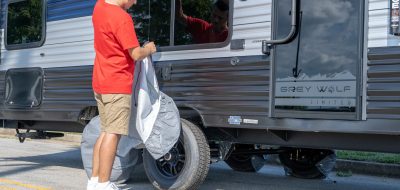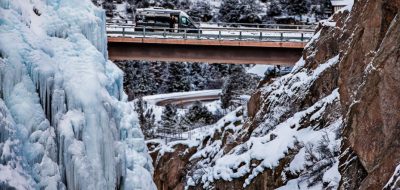There is so much freedom when it comes to traveling in an RV. However, getting behind the wheel of one for the first time can be intimidating. It is not just the size of an RV that takes some getting used to—it is being aware of the challenges that come with piloting a big rig. Here are six valuable tips for driving large RVs that will keep you and your rig safe.
Pre-Flight inspection
Just like a plane needs a pre-flight check before heading into the skies, drivers need to check their rig prior to getting on the road. Before you even get in the RV, walk around the rig and check to make sure the tires are inflated correctly, all the hoses and power cords are stored away, all slide-outs are back in place, all doors are closed, and there are no large objects in the way of the vehicle (like tree branches).
Get Help
In a large RV, there are significant blind spots. So don’t be afraid to ask your co-pilot or even fellow RVer to help guide you in or out of a space. RV drivers are always willing to help each other out!
It’s Not NASCAR
RVs have powerful engines, but that is no reason to speed. Lower speeds not only save money at the pump, they also make you safer on the road. By maintaining a constant moderate speed, drivers can save up to 30 percent on fuel and are better able to react to road conditions and other drivers.
Don’t Rock the Boat
RVs have a high center of gravity, so don’t make sudden lane changes or sharp turns, which could lead to the RV yaws or rocking back-and-forth. Take sharp corners a little wider than you would with a normal vehicle. If large gusts of wind hit your RV, don’t overcorrect. Try to get the RV level and drive in a straight line.
Be Prepared
Don’t head out onto the road in the RV without being prepared. Make sure your big rig is stocked with extra water, roadside emergency tools (flares, caution signs), guides, and a reliable atlas.
As you see, a few small preparations and adjustments to your driving habits can go a long way when driving a large vehicle such as an RV. Happy and safe travels!





Paul Allen
I purchased a 2007. Keystone, Montana 5th wheel with 5 slide outs and in the 5 years I have owned it I have had 6 blowouts! I was given advice to switch from D to E size tires which I did but just recently on our trip across country I experienced 3 of the 6 blowouts with the type E tires! Our 5th wheel looks like its 20 years old. The side covers over the tires ripped off and took some of the siding which I already replaced twice. Has anyone e,se experienced this problem or do I just have a lemon? My stickers are all peeling off as well!
Any advice?
Mike (Stody)Stodelle
With as large as the campground directory is getting, has any thought been given to making an application for use with an electronic tablet or computerizing it? The it could be enlarged for those with reading issues etc and would free up some cupboard space.
Ray Miller
Love the magazine.
When doing your pre-flight inspection remember to check to make sure you raise your leveling jacks and if you’re towing remember to check all safety chains and/or cables as well as electrical cables. No need to mention to check the hitch to make certain it’s locked with a bolt or lock.
Al Stevens
Hi Sam
I use the “RV Parks & Campgrounds Directory” all of the time, and I have been using it for more that 20 years. The Directory is getting too large and heavy… The time has come to publish it in to two or three regional volumes.
Thanks for all you do for for the RV’ers. Al Stevens